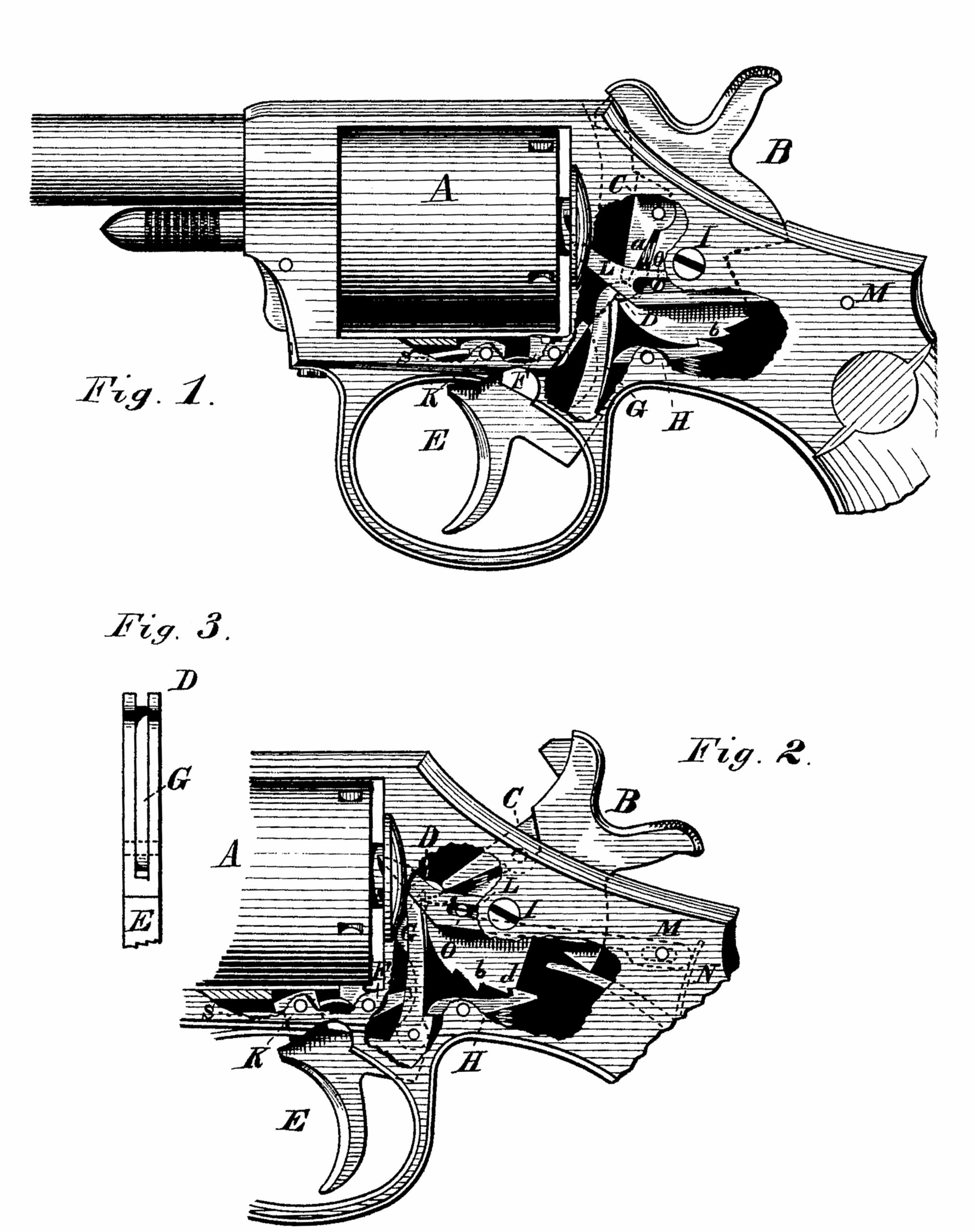US 204438
UNITED STATES PATENT OFFICE.
IVER JOHNSON AND MARTIN BYE, OF WORCESTER, MASSACHUSETTS.
IMPROVEMENT IN REVOLVING FIRE-ARMS.
Specification forming part of Letters Patent No. 204,438, dated June 4, 1878; application filed February 8, 1878.
To all whom it may concern:
Be it known that we, IVER JOHNSON and MARTIN BYE, both of the city and county of Worcester, State of Massachusetts, have invented a new and useful Improvement in Revolving Fire-Arms, of which the following is a specification:
Our invention, though applicable to various forms of fire-arms, relates more particularly to that class of revolvers known as having a “double action,” or as capable of being fired repeatedly by merely pulling the trigger, like “self cockers,” or by cocking by means of the hammer, in the usual way, at the option of the operator.
In this class of fire-arms as heretofore made, the hammer does not have the same amount of motion when cocked or fired by the trigger that it does when cocked by the hammer, (usually only about one-half.) Consequently the cylinder is not rotated as far in one case as in the other, which is objectionable, and is overcome by our invention, which gives the hammer the same motion when fired either way, and simplifies the parts that give motion to the cylinder, and provides for the unlocking and locking of the cylinder by a simple and effective arrangement.
In the accompanying drawings, Figure 1 shows a side view of a revolver embodying our invention, with some portions of the case removed and the parts in position of rest, or with the hammer held a little off the cartridge in the cylinder. Fig. 2 is the same with the parts at full-cock, or as nearly released for firing. Fig. 3 shows a rear view of the trigger-extension and its pivoted lever.
The same letters indicate the same parts wherever they occur.
A is the cylinder, having a ratchet at its rear end and stop-notches, as shown. B is the hammer. C is a stirrup, pivoted to B, its upper end fitting against B, and preventing any more outward motion of its lower end than as shown, the spring a allowing its lower end to move slightly toward B to pass the head D of the trigger E as the latter returns to place after firing. F is the stop-lever, having a spring to hold its forward end up into the notches in the cylinder A, and a tail whereby a cam-lever, G, when pressed forward by the lower part of the hammer, releases said stop-lever from the cylinder, the lever G being pivoted in a slot in the extension of the trigger E, as shown in Fig. 3, allowing it to pass the stop lever F after firing. H is a tilting lever with catch on its rear end, holding the hammer at half-cock by notch b, and at full-cock by notch d, its fore end extending over the rear of the trigger E, to be raised to release the catch in the act of firing. L is a slotted lever, its rear end resting on a pin, M, in a slot, and a spring, N, pressing it forward, the other end being pointed, and fitting into the ratchet on the end of cylinder A. O is a pin or stud in the tumbler of hammer B, so situated below its pivot as to give the proper motion to L, in a slot of which it works to move the cylinder A one division at every full motion of the hammer, and on the return of the hammer the spring N allows the piece L to pass the next notch of the ratchet. The lever G is curved on its front to allow the stop-lever F to press against the cylinder in time to arrest it when fired quickly.
By this construction we simplify the parts, and give a sure equal motion both to the cylinder and hammer in firing, whether it be done by the trigger alone or cocked first by the hammer.
By a slight variation of the notch d or the catch on H it may be made to release exactly at the time the head D slips from the stirrup C, or a little before or after that time, if desired. We prefer a little before as the best time.
The other parts of the fire-arm not described may be of the usual form and construction, with such slight modifications as will adapt them to our invention..
We are aware that double-acting revolvers have been made as shown in Patent No. 193,367, and others whose motions are not equal. These we do not claim.
We claim-
1. In a self-cocking revolver, the combination of the cylinder A, the stop-lever F, the lever, G, the tumbler B, having a half-cock notch, b, and the tilting catch-lever H, substantially as set forth.
2. The combination of the cylinder A, lever F, and lever G, pivoted on the trigger E, and operated by hammer B, substantially as and for the purposes described.
3. In a self-cocking revolver, the combination of a self-firing mechanism, consisting of the trigger-head D, acting on the stirrup C, pivoted to the hammer B, and an equal-motioned full-cocking mechanism, consisting of the tilting lever H, holding by the full-cock notch d, and released by the rear of the trigger E, so that the hammer will be released at or about the same point, whether cocked by hand or automatically by a pull on the trigger, as set forth.
4. In a revolver, the combination of cam-lever G, operated by the hammer B, and a cylinder stop mechanism, substantially as and for the purposes set forth.
IVER JOHNSON,
MARTIN BYE.
Witnesses:
NAHUM M.D. HAYWARD,
JAS. G. ARNOLD.

